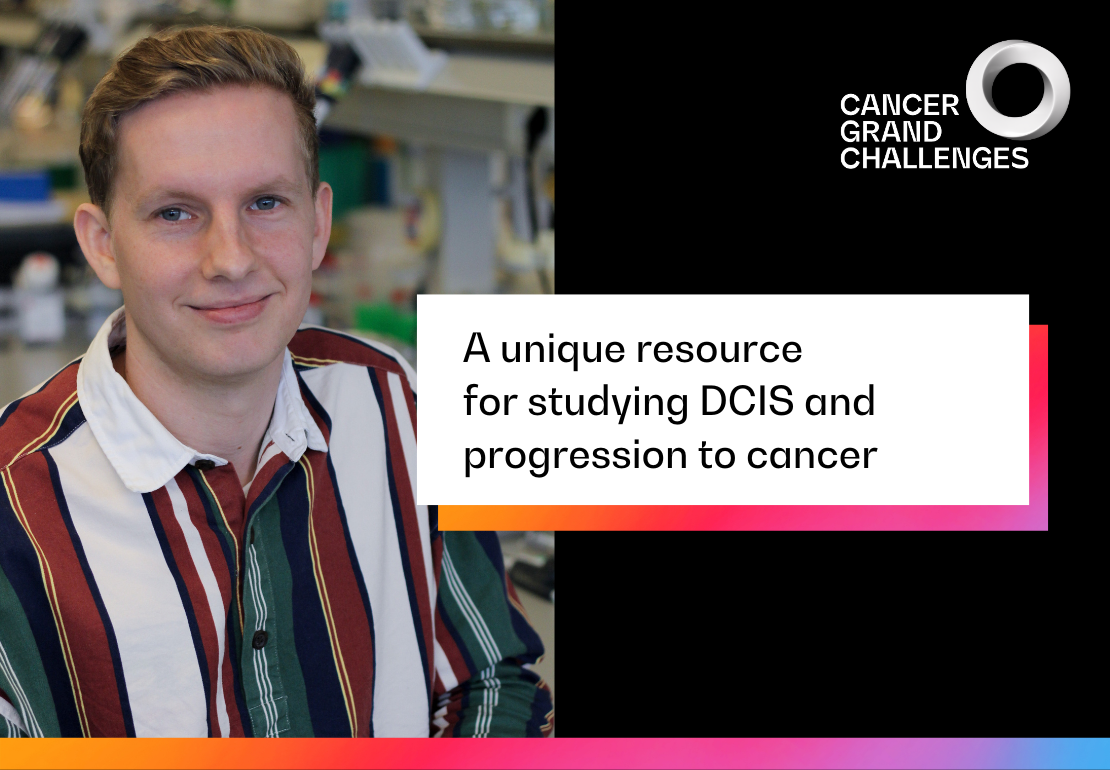Members of the Cancer Grand Challenges PRECISION team have developed a living biobank of 115 patient-derived Mouse-INtraDuctal (MIND) ductal carcinoma in situ (DCIS) models and used them to identify risk factors associated with progression to invasive breast cancer.
DCIS is the presence of abnormal but non-invasive cells in the breast milk ducts. In a small number of cases, DCIS can progress to invasive breast cancer, but there is currently no way to distinguish those cases that will progress and those that won’t. The PRECISION team, taking on our Lethal vs Non-lethal challenge, is working to find ways to make this distinction, which could spare thousands of women around the world unnecessary treatment.
We spoke to Stefan Hutten, first author of the paper published today in Cancer Cell, to find out more about the findings from the study and how these models could help to accelerate research on the mechanisms of DCIS progression. Stefan is a PhD student in the PRECISION team, based at the Netherlands Cancer Institute.
What are the key findings from the study?
We wanted to develop models that could be used to track what would happen to DCIS lesions without surgery – would they progress to invasive breast cancer or not?
We have created a collection of patient-derived xenograft (PDX) models by intraductal injection into immunocompromised mice that we can follow over a 12-month period. Using different ‘omics methods, we compared the two groups to characterise the differences observed between DCIS cases that progressed to invasive cancer and those that did not.
The main differences we found were that DCIS lesions that did progress to invasive breast cancer overall had a higher copy number aberration burden and, in a lot of cases, were HER2 positive.
We also looked at 3D growth patterns in our study. We saw two distinct growth patterns – replacement growth, which didn’t change the architecture of the mammary gland when the lesion grew; and expansive growth, where the lesion grew perpendicular to the ductal system and put a lot of pressure on the ducts. The latter growth pattern may eventually lead to the breakage of the duct and correlated with invasive progression.
I think the most important thing we bring in this paper, which will further accelerate research into DCIS, is that we have developed a collection of 19 DCIS models that can be transplanted over multiple generations that can be shared with the wider research community for further research.
What impact do you hope this work will have on patients with DCIS?
Our paper provides important direction on which parameters or markers could potentially predict invasive progression in women with DCIS. We have developed a resource that could be used to further test biomarkers that we predict could be important markers in patients before proceeding with clinical trials.
A difficulty with clinical trials for DCIS is that it can take 10-20 years to follow its progression and see the differences between patient groups that do progress and those that don’t. Using our PDX models, we can monitor these differences in a much shorter timeframe, and the information gained may provide direction on how to create better clinical trials for patients.
In 20 years, how would you like the DCIS field to have progressed? How do you think your models will have helped?
I think that the models we have created vastly improve the modelling space for DCIS. Currently, in vivo DCIS work uses cell lines that don’t always have the common characteristics that most people with DCIS have. Our models still resemble the lesion of the original patient that the sample was taken from. So being able to mimic the patient lesion more directly will really help with making future findings more clinically relevant.
In 20 years, I hope there will be a paradigm shift in how we think about preinvasive cancer and cancer risk. Currently, a diagnosis of DCIS can lead to severe psychological effects for the patient, as they perceive the risks to be similar to patients with invasive breast cancer and usually undergo the same treatment regardless of whether their DCIS would progress or not. As we and other research groups have shown, most DCIS cases will not become dangerous, and I hope in the future we will be able to better assess prognosis in DCIS patients, dividing patients into three groups. A low-risk group, which receives active surveillance; a high-risk group, which should receive the current standard of care; and a medium-risk group, where the physician makes an informed decision together with the patient about the course of action.
Why was the Cancer Grand Challenges approach important for this work?
This is the type of research that could only have been done with the Cancer Grand Challenges approach. Firstly, the size of our study and the researchers required for the study needed the support of an initiative of this scale. On top of this, the techniques and the ‘omics and imaging data that we had access to was only possible because we had such a large international group of people with different specialities. For example, we worked closely with Fariba Behbod (the University of Kansas Medical Centre) and were able to exchange experiences and techniques, which made it possible to create these transplantable models. Without these international collaborations, I don’t think this work would have been possible.
The patient DCIS samples used in this study were obtained from patients that underwent surgery at the Netherlands Cancer Institute. The researchers would like to express their thanks to the patients who donated their tissue and made this research possible.

